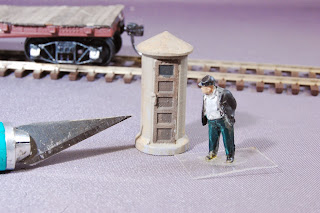The printed models aren't necessarily a big win over buying commercial cars, nor are they museum-quality; I'm not looking for perfection, just some recognizable models that I can't get elsewhere. Each one of the flat cars requires some finishing and painting. Then the wood deck needs to be stained and glued on, details like the grab irons and brake wheels need to be added. Finally, the cars need to be decaled.
Today's story, though, is about the detailing part. I haven't been putting elaborate brake detail on these cars, but the old-fashioned K-style brake cylinder is a pretty visible detail and worth adding. I had been buying the Tichy plastic brake gear detail kits, but (1) I kept buying out the Train Shop's stock, and (2) at some point paying $3 to grab one little casting seemed wasteful, especially if I want a bunch of cars.
Hey, wait, don't I have a 3d printer?
So, I tried it - took some guesses at measurements, drew something up over a couple hours in SketchUp, and printed it. And it worked - the Form One did a most excellent job on a tiny brake cylinder.
So I upped the detail, adding bolt heads and even the very fine piston rod and clevis. I printed all these at the 0.025" setting on the Form One. A few hours later, I had a dozen brake cylinders, ready for the next set of cars. The photos are worth sharing; if I ever had any doubts about whether the Form One would help me in modeling, this particular piece convinced me. Zoom in to see that the clevis fork printed (though only half printed fully), and notice the bolt detail both around the top of the cylinder, and on the mounting plate at the back of the model.
As a modeler that buys a fair number of detail parts, these brake cylinders completely change the game - I'm no longer dependent on what's available from the store or what's in stock, but instead on what I can manage to draw in a 3d program.
For the folks who are curious how I drew the brake cylinder:
The first step was to get some rough measurements off one of the commercial parts and off official drawings. Once I had rough shapes, I drew a 2d cross-section of the piece's shape, and drew a circle the size of the cylinder bottom in SketchUp. Once I had these, SketchUp's "Follow Me" tool allowed me to drag that cross section around the circle, making what the high school geometry teachers might call a surface of rotation. That gave me the rough 3d object; I extruded 1" diameter, 1" tall cylinders wherever I wanted bolts. The clevis fork was similarly extruding a circle from the cylinder top, then sketching the rectangular shapes on top of that to make the clevis.
The hardest part was the mounting plate on the top of the cylinder. I did this by drawing a 10x16" x 2" thick block, and moving it so it sat on top of the cylinder. Now, this doesn't work so hot because SketchUp doesn't like figuring out the intersections between curved and flat surfaces, so it just leaves the top half of the cylinder inside the block. To make a 3d-printable shape, I deleted the top face of the mounting plate and drew extra edges at the intersection between the round and square faces, then deleted the parts of the cylinder that were stuck inside the plate.
That's pretty sweet work on a part that's less than 3/4" long, and only around 1/8" in diameter. And that part is starting to get to injection molded quality. Tichy's part is a little finer,includes the Westinghouse logo and cylinder size cast right on the side, and its ABS probably can take a bit more abuse than the Form Labs resin. On the negative side, when I look at the commercial part with a magnifying glass (and I'm using that magnifying glass a lot these days), it's easy to see that the mold was misaligned, and the two halves of the part didn't match up.
















